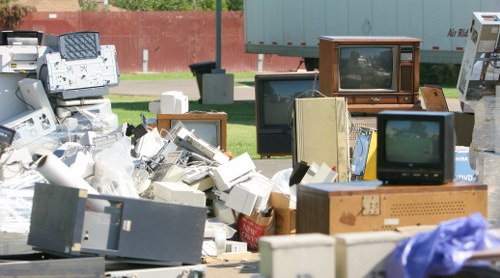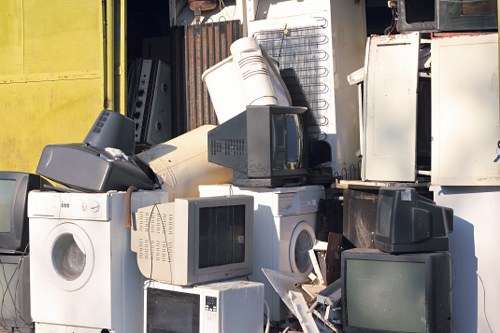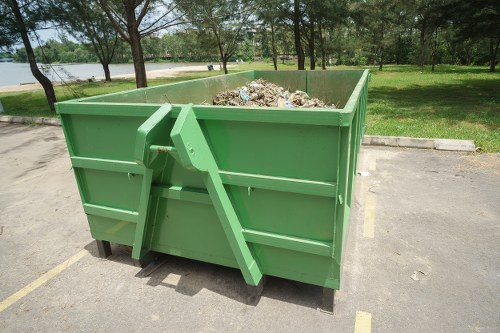Effective Home Clearance in Office Clearance: A Comprehensive Guide

Home clearance and office clearance are essential services that cater to individuals and businesses alike. Whether you're relocating, downsizing, or simply decluttering, understanding the nuances between home and office clearance can save you time, money, and stress.
In this article, we will delve into the similarities and differences between home clearance and office clearance, providing you with the necessary information to make informed decisions. From the types of items typically cleared to the best practices for a smooth clearance process, we've got you covered.
Let's begin by exploring what each type of clearance entails and why they are important in today's fast-paced world.
Understanding Home Clearance

Home clearance involves the removal of unwanted items from residential properties. This can range from old furniture, appliances, clothing, to personal memorabilia. The primary goal is to create a more organized and functional living space.
Reasons for home clearance include moving to a new house, decluttering for a more minimalist lifestyle, or clearing out an estate. The process not only helps in optimizing space but also in donating or recycling items, thereby promoting sustainability.
Effective home clearance requires careful planning. Start by assessing the items you no longer need, categorizing them based on their condition and potential for reuse. Hiring professional clearance services can streamline this process, ensuring that everything is handled efficiently and responsibly.
Benefits of Home Clearance
Engaging in regular home clearance offers numerous benefits:
- Improved Living Space: Removing unnecessary items creates a cleaner and more spacious environment.
- Enhanced Safety: Decluttering reduces the risk of accidents caused by tripping over cluttered areas.
- Environmental Impact: Proper disposal and recycling of items contribute to environmental conservation.
- Emotional Well-being: A tidy home can significantly improve mental health and reduce stress levels.
Implementing a regular clearance routine ensures that your home remains organized and free from clutter.
Exploring Office Clearance

Office clearance refers to the process of removing outdated or unused items from a workspace. This can include office furniture, electronic equipment, documents, and other office supplies. The aim is to maintain an efficient and productive work environment.
Businesses may require office clearance for various reasons such as relocating to a new premises, downsizing operations, or simply optimizing current workspace usage. Effective office clearance can lead to cost savings, improved employee morale, and a more organized office layout.
Similar to home clearance, office clearance involves assessing items for disposal, donation, resale, or recycling. Professional office clearance services can handle large quantities of items, ensuring compliance with regulations and minimizing disruption to business operations.
Advantages of Office Clearance
Office clearance offers several key advantages:
- Cost Efficiency: Reducing excess inventory and equipment can lead to significant cost savings.
- Enhanced Productivity: A clutter-free office environment can boost employee efficiency and focus.
- Space Optimization: Clearing redundant items allows for better utilization of office space.
- Compliance and Security: Proper disposal of sensitive documents and equipment ensures compliance with data protection laws.
Implementing regular office clearance can foster a more dynamic and productive workplace.
Key Differences Between Home and Office Clearance

While home clearance and office clearance share similarities, there are distinct differences in their approach and execution:
- Volume of Items: Office clearances generally involve larger volumes of items compared to home clearances.
- Types of Items: Office clearances may include specialized equipment like computers, printers, and office furniture.
- Regulatory Compliance: Office clearances often require adherence to strict data protection and environmental regulations.
- Timing and Scheduling: Office clearances may need to be coordinated around business hours to minimize disruption.
- Valuation and Resale: Businesses may seek to resell or repurpose certain items, adding a layer of complexity to the clearance process.
Understanding these differences is crucial for selecting the appropriate clearance strategy and service provider.
Choosing the Right Clearance Service
Selecting a reputable clearance service is vital for a successful clearance process. Here are some factors to consider:
- Experience and Expertise: Look for companies with a proven track record in both home and office clearance.
- Comprehensive Services: Ensure the service provider offers a full range of services, including sorting, removal, recycling, and disposal.
- Environmental Responsibility: Choose companies that prioritize eco-friendly practices, such as recycling and donating usable items.
- Customer Reviews and Testimonials: Research customer feedback to gauge the reliability and quality of the service.
- Transparent Pricing: Opt for services that provide clear and upfront pricing without hidden fees.
Taking the time to evaluate potential clearance services will ensure that your specific needs are met effectively.
Step-by-Step Clearance Process

Whether you're undertaking a home or office clearance, following a structured process can enhance efficiency and outcomes. Here’s a step-by-step guide to help you navigate the clearance process:
1. Assessment and Planning
Begin by evaluating the scope of the clearance. Identify the areas that need attention and list the items to be cleared. Establish a timeline and allocate resources accordingly.
2. Sorting and Categorizing
Sort items into categories such as keep, donate, sell, recycle, and dispose. This classification helps in streamlining the removal process and ensures responsible disposal.
3. Removal and Transportation
Arrange for the removal of items, ensuring that they are transported safely and efficiently. Professional clearance services can handle this step, mitigating the risk of damage or loss.
4. Cleaning and Restoration
After the removal of items, perform a thorough cleaning of the space. This step is crucial for both home and office clearances to restore the area to its optimal condition.
5. Final Inspection
Conduct a final inspection to ensure that all items have been cleared and the space meets the desired standards. Address any remaining issues promptly.
Following these steps will help you achieve a smooth and effective clearance, tailored to your specific needs.
Planning Your Clearance Efficiently
Effective planning is the cornerstone of a successful clearance. Here are some tips to help you plan efficiently:
- Set Clear Objectives: Define what you aim to achieve with the clearance, whether it's freeing up space, reducing clutter, or preparing for a move.
- Create a Timeline: Establish deadlines for each phase of the clearance to stay on track and avoid delays.
- Allocate Resources: Determine the manpower and tools required for the clearance. Professional services can provide the necessary resources.
- Communicate Effectively: If clearing an office, ensure that all employees are informed and cooperate with the clearance process.
- Budget Appropriately: Set a budget that covers all aspects of the clearance, including removal, disposal, and any unexpected costs.
Proper planning ensures that the clearance process is organized, efficient, and stress-free.
Eco-Friendly Clearance Practices
In today's environmentally conscious world, adopting eco-friendly clearance practices is more important than ever. Both home and office clearances can be conducted in a sustainable manner by following these guidelines:
Recycle and Donate
Instead of discarding items, recycle or donate them to charities and organizations. This not only reduces waste but also benefits those in need.
Proper Disposal of Hazardous Materials
Ensure that hazardous materials such as electronics, batteries, and chemicals are disposed of according to local regulations. Many clearance services specialize in the safe disposal of such items.
Minimize Waste
Plan the clearance to minimize waste generation. This can involve reusing packaging materials or repurposing items where possible.
Choose Sustainable Clearance Services
Opt for clearance companies that prioritize sustainability in their operations. Look for certifications and commitments to environmentally friendly practices.
Implementing eco-friendly practices during clearance not only protects the environment but also enhances your reputation as a responsible individual or business.
Legal Considerations in Office Clearance
Office clearance often involves handling sensitive documents and equipment, which necessitates attention to legal considerations. Here are key aspects to keep in mind:
- Data Protection: Ensure that all confidential information is securely destroyed to comply with data protection laws.
- Compliance with Regulations: Adhere to local and national regulations regarding the disposal of electronic waste and other materials.
- Contracts and Agreements: If engaging a clearance service, review contracts carefully to ensure they meet legal requirements and protect your interests.
- Liability and Insurance: Verify that the clearance service has appropriate insurance coverage to handle any potential damages or losses.
Addressing these legal considerations is crucial to avoid potential liabilities and ensure that the clearance process is conducted lawfully.
Ensuring Security During Clearance
Security is paramount during office clearance, especially when dealing with sensitive information and valuable equipment. Here are steps to ensure security:
- Data Destruction: Use professional shredding services for confidential documents and degaussing for electronic storage devices.
- Inventory Management: Keep a detailed inventory of all items being cleared to track their removal and disposal.
- Access Control: Limit access to the clearance area to authorized personnel only.
- Secure Transportation: Ensure that items are transported securely to prevent loss or theft.
Implementing these security measures safeguards your business's integrity and maintains trust with stakeholders.
Cost Factors in Clearance Services
The cost of clearance services can vary based on several factors. Understanding these can help you budget effectively:
Volume and Weight of Items
The more items you need to clear, the higher the cost. Services may charge based on the volume or weight of the items being removed.
Type of Items
Specialized items like electronics, hazardous materials, or bulky furniture may incur additional charges due to the complexity of their disposal.
Location
The geographical location can affect pricing. Clearance services in urban areas may have different rates compared to those in rural regions.
Level of Service
Comprehensive services that include sorting, cleaning, and disposal will typically cost more than basic removal services.
Timing
Urgent or same-day clearance requests may incur a premium compared to standard scheduling.
By understanding these cost factors, you can select a clearance service that aligns with your budget and requirements.
Budgeting for Clearance
Effective budgeting ensures that you allocate sufficient funds for the clearance without overspending. Here are some tips:
- Get Multiple Quotes: Obtain quotes from several clearance services to compare prices and services offered.
- Assess Your Needs: Clearly define the scope of the clearance to avoid unnecessary expenses.
- Plan Ahead: Scheduling clearance in advance can help you secure better rates and manage your budget efficiently.
- Consider Hidden Costs: Be aware of potential additional charges for specialized items or urgent requests.
By carefully planning and budgeting, you can manage clearance costs effectively while ensuring quality service.
Maximizing Efficiency in Clearance
Maximizing efficiency during clearance can save time and resources. Here are strategies to enhance the efficiency of your clearance process:
Organize and Label
Organize items into clearly labeled categories. This facilitates easier sorting and reduces time spent searching for specific items.
Use Technology
Leverage technology such as clearance management software or apps to track items, schedule removals, and manage inventory.
Delegate Tasks
Delegate specific tasks to team members or hire professionals to handle different aspects of the clearance, ensuring that the process moves smoothly.
Streamline Communication
Maintain clear and constant communication with all parties involved, including clearance services, to coordinate efforts and address issues promptly.
Regular Reviews
Conduct regular reviews of the clearance process to identify bottlenecks and implement improvements.
Implementing these strategies can significantly enhance the efficiency of your clearance operations, leading to better outcomes and satisfaction.
Utilizing Professional Clearance Services
Professional clearance services bring expertise and resources that can greatly benefit both home and office clearances. Here's how:
- Expertise: Professionals are trained to handle all aspects of clearance, from sorting to disposal.
- Equipment: They have the necessary tools and vehicles to manage large-scale removals efficiently.
- Time-Saving: Hiring experts frees up your time to focus on other important tasks.
- Compliance: Professional services ensure that all disposal practices comply with relevant laws and regulations.
- Safety: Experts are skilled in handling heavy or hazardous items safely, reducing the risk of injury.
Engaging professional clearance services can lead to a more organized, efficient, and hassle-free clearance experience.
Post-Clearance Organization Tips
After completing your clearance, it's essential to maintain the organization achieved. Here are some tips for post-clearance organization:
Implement Storage Solutions
Use storage solutions like shelving units, cabinets, and bins to keep remaining items organized and easily accessible.
Adopt a Minimalist Approach
Embrace a minimalist lifestyle or office setup by keeping only essential items, thereby reducing future clutter.
Regular Maintenance
Schedule regular maintenance checks to ensure that the space remains organized and clutter-free.
Digital Organization
For offices, consider digitizing documents and files to minimize paper clutter and enhance accessibility.
Set Organizational Guidelines
Establish clear guidelines for organizing and storing items to maintain consistency and order.
Implementing these post-clearance organization tips can help sustain a clean and efficient environment, enhancing both your living and working spaces.
Maintaining an Organized Space
Maintaining an organized space requires ongoing effort and commitment. Here are practical steps to help you stay organized:
- Declutter Regularly: Schedule periodic decluttering sessions to prevent the accumulation of unnecessary items.
- Assign Specific Places: Ensure that every item has a designated place, making it easier to find and put away.
- Limit New Items: Be mindful of bringing new items into your home or office, opting for quality over quantity.
- Use Labels: Label storage containers and shelves to maintain order and facilitate easy retrieval of items.
- Encourage Participation: In an office setting, encourage all employees to participate in maintaining the organized space.
By consistently applying these practices, you can preserve the benefits of a successful clearance and maintain an organized environment long-term.
Conclusion
Home clearance and office clearance are integral processes that contribute to a more organized, efficient, and pleasant living and working environment. By understanding the differences and similarities between the two, you can tailor your clearance efforts to meet your specific needs effectively.
Whether you're clearing your home to create a more comfortable living space or organizing your office to enhance productivity, following a structured clearance process and adopting best practices can lead to outstanding results.
Ready to transform your space? Contact us today to book your clearance service and take the first step towards a clutter-free environment.